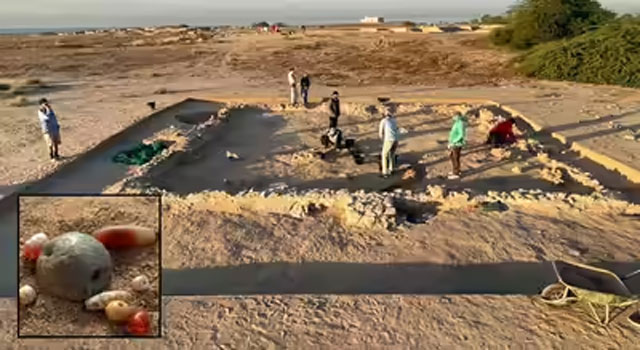Daijiworld Media Network – Kuwait
Kuwait, Oct 27: Failaka Island has revealed one of its most remarkable archaeological discoveries in decades — a 4,000-year-old temple belonging to the ancient Dilmun civilization. Unearthed by a joint Kuwaiti–Danish archaeological team, the find confirms the island’s historic role as a vital religious and administrative centre during the Bronze Age.
According to the National Council for Culture, Arts and Letters (NCCAL), this is the second Dilmun temple discovered on the exact same site — a rare example of two temples built one atop another between 1900 and 1800 BCE. The excavation took place at Tell F6, east of the Dilmun palace area, where archaeologists uncovered the temple’s full layout, complete with foundations, pottery, and seals linked to early trade.

Mohammed bin Redha, Acting Assistant Secretary-General for the Antiquities and Museums Sector at NCCAL, said, “The discovery confirms the existence of two temples built on the same site, both dating back roughly 4,000 years.” He emphasized the government’s commitment to preserving Kuwait’s ancient heritage through continued archaeological missions.
Excavation supervisor Dr Ole Herslund noted that earlier digs had revealed only wall fragments, but this season’s work exposed a complete multi-roomed structure. The discovery included pottery sherds typical of early Dilmun craftsmanship, trade seals, beads, and carved fragments believed to have ceremonial significance.
Archaeologists say the temple’s floor plan and central chamber resemble ritual buildings found in Bahrain and eastern Arabia, reinforcing Failaka’s importance within the Dilmun religious and trade network.
Situated at the maritime crossroads between Mesopotamia, eastern Arabia, and the Indus Valley, Failaka was a hub for the Dilmun civilization — one of the earliest organized societies in the Gulf region. The new find highlights the island’s role not only as a trade outpost but also as a permanent settlement and spiritual centre.
Experts say the discovery provides a clearer picture of the Gulf’s ancient identity, showing that the region was deeply integrated into global trade and cultural exchanges long before modern times.
This temple, now standing as a silent witness to the Dilmun era, offers Kuwait a profound link to its 4,000-year-old roots — a living reminder of a civilization that once thrived on the shores of the Arabian Gulf.